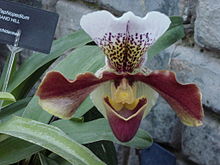Cypripedioideae
| Lady's slipper orchid | |
|---|---|

| |
| Slipper orchid of the genus Paphiopedilum | |
| Scientific classification | |
| Kingdom: | Plantae |
| Clade: | Tracheophytes |
| Clade: | Angiosperms |
| Clade: | Monocots |
| Order: | Asparagales |
| Family: | Orchidaceae |
| Subfamily: | Cypripedioideae Kostel. |
| Genera | |
|
See text and Taxonomy of the orchid family .
| |

| |
| Cypripedioideae genera range | |
Cypripedioideae is a
Description
All representatives of the Cypripedioideae are perennial, herbaceous plants. The fleshy roots sometimes possess a veil. The leaves are arranged spirally or in two rows, the shoot is slender or compressed. In the bud, the leaves are rolled and the leaf blade is plikat (folded) or the leaves are folded in the bud, smooth and leathery. There is no dividing tissue between leaf and shoot.[citation needed]
The
Chromosome numbers vary within the subfamily over a wide range from 2n=20 in Cypripedium to 26 to 44 chromosomes in Paphiopedilum. The chromosomes are quite large.[citation needed]
The species in this subfamily form trap flowers in which insect access to the saclike lip from the front is quite easy. The inside is designed in such a way that the insects climb out of the flower past the stigma and the stamens and thereby pollinate the flower.
Distribution
The species in the subfamily Cypripedioideae are found in northern South America and Central America (Mexipedium, Phragmipedium, Selenipedium), circumboreal in North America, Europe, Africa (Algeria[2]) and in northern Asia (Cypripedium) as well as in subtropical and tropical Southeast Asia (Paphiopedilum). They do not occur in Australia and Africa. The spread could have started from a center of origin in Central America.[citation needed]
Taxonomy
Unlike most other orchids, slipper orchids have two fertile

The subfamily Cypripedioideae is
- Cypripedium, found across much of North America, as well as in parts of Europe (one species), Africa (only in Algeria has been discovered in 2019[6]) and Asia. The state flower of Minnesota is the showy lady's slipper (Cypripedium reginae); the pink lady's slipper (Cypripedium acaule) is the official flower of the Canadian province of Prince Edward Island.
- Mexipedium, a monotypic genus, consisting of a single species that was found in a single locality in Oaxaca, Mexico.
- Paphiopedilum, found in the tropical forests of southeast Asia reaching as far north as southern China. Paphiopedilum is quite easy to cultivate and therefore is popular among orchid enthusiasts. In fact, over-collection of this genus has been so extensive that many species are now sub-viable in their natural habitats.
- Phragmipedium, found across northern South and Central America, is also easy to cultivate as it requires lower temperatures than Paphiopedilum, eliminating the need for a greenhouse in many areas.
- Selenipedium, found in Central and South America.
Intergeneric hybrids
Hybrids between the genera in this subfamily are placed in the following nothogenera:[7]
- × Cyphiopedilum (Cphd.) = Cypripedium × Paphiopedilum
- × Cyphragmipedium (Cgd.) = Cypripedium × Phragmipedium
- × Phragmipaphium (Phrphm.) = Paphiopedilum × Phragmipedium
Hybrids with genera outside of the subfamily are not known as of 2017.
References
- ISBN 0-88192-183-1.
- ISSN 1120-4052.
- ^ Rasmussen, F. N. 1985. "Orchids". In R. M. Dahlgren, H. T. Clifford, and P. F. Yeo [eds.], The families of the monocotyledons. Springer Verlag, Berlin.
- ^ K. W. Dixon, S. P. Kell, R. L. Barrett and P. J. Cribb (eds) 2003. "DNA Data and Orchidaceae Systematics: A New Phylogenetic Classification". Orchid Conservation. pp. 69–89. Natural History Publications, Kota Kinabalu, Sabah.
- PMID 20211743. Archived from the original(PDF) on 2019-12-31.
- ^ Walid, Nemer & Rebbas, Khellaf & Krouchi, Faiza. (2019). Découverte de Cypripedium calceolus (Orchidaceae) au Djurdjura (Algérie), nouvelle pour l’Afrique du Nord. Flora Mediterranea. 29. 207-214. 10.7320/FlMedit29.207.
- ^ Alphabetical One-Table List of Genera and Intergeneric Hybrids, Royal Horticultural Society, 2017.
Further reading
- Cox, A. V., A. M. Pridgeon, V. A. Albert, and M. W. Chase. 1997. Phylogenetics of the slipper orchids (Cypripedioideae: Orchidaceae): nuclear rDNA ITS sequences. Plant Systematics and Evolution 208: 197–223. Abstract
- Pridgeon, A. M.; Cribb, P. J.; Chase, M. W. & F. N. Rasmussen (1999): Genera Orchidacearum Vol. 1, Oxford U. Press. ISBN 0-19-850513-2
External links
 Media related to Cypripedioideae at Wikimedia Commons
Media related to Cypripedioideae at Wikimedia Commons Data related to Cypripedioideae at Wikispecies
Data related to Cypripedioideae at Wikispecies- The Slipper Orchid Alliance
- SlipperOrchids.info
